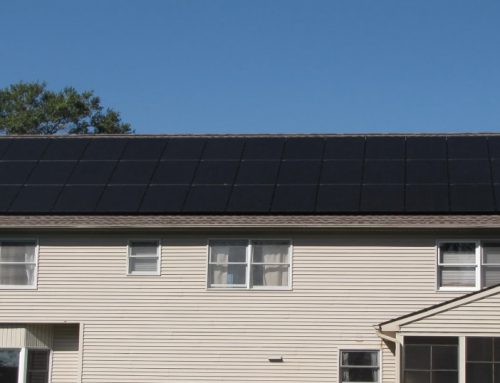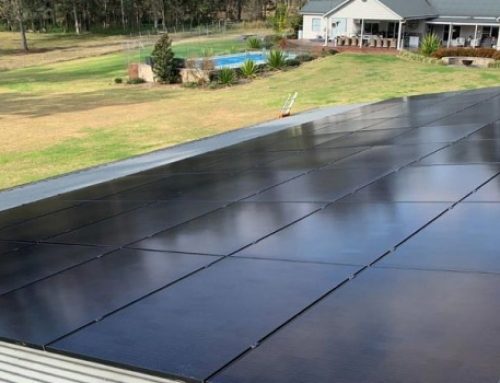Are your solar panels free of dirt, debris and grime?
More than a matter of looks, dirty panels can lead to inefficient energy production and rob you of the savings you deserve.
In this guide, we’ll show you how to clean your solar panels and potentially boost your system’s efficiency and longevity.
Dust, bird droppings, and leaf litter can all impair your solar panel’s ability to capture sunlight, potentially putting a dent in your energy savings.
Thankfully, keeping your panels pristine isn’t as complex or as daunting as it might seem.
This tutorial will guide you through the considerations, steps, and tips necessary to ensure your solar panels remain as efficient as the day they were installed.
From understanding the best time to undertake cleaning to selecting the right tools for the job, we’ve got you covered.
Solar Panel Cleaning Overview
The performance of solar panels isn’t solely dependent on technology or the amount of sunlight they receive. Efficiency is also heavily influenced by how clean they are.
Dirt, debris, and other materials that accumulate on the surface of panels can obstruct sunlight, reducing the amount of energy that these panels can generate.
This is where the service of solar panel cleaning steps into the spotlight.
Professional cleaning services specialise in the care and maintenance of panels, ensuring they operate at peak efficiency.
By using specialised equipment and techniques, these services can safely remove dirt, bird droppings, leaves, and other pollutants without damaging the delicate photovoltaic cells.
The benefits of regular solar panel cleaning are multifold:
- Increased Efficiency: Clean panels mean more surface area is available to absorb sunlight, directly translating to more electricity generated.
- Extended Lifespan: Keeping panels clean helps prevent material degradation, ensuring they last as long as possible.
- Cost Savings: By maximising energy production, clean solar panels can significantly reduce your energy bills.
- Performance Monitoring: Regular cleaning services often include checks for any damage or issues, allowing for early detection and repair.
Matching Services to Your Solar Needs
Before you jump on the phone and call up a maintenance team, you must understand your home or property’s specific needs.
Location and Environment:
The amount of dust, pollen, bird droppings, and leaf litter your panels will collect can vary greatly depending on your property’s location.
Coastal areas might deal with salt spray, while homes near busy roads may accumulate more dust and soot. Properties surrounded by trees may require more frequent cleanings due to leaves and sap.
Roof Characteristics:
The slope and type of your roof can affect how easily your solar panels can be cleaned.
Steeper roofs pose more of a challenge and may require special safety equipment, while flat roofs might allow debris to accumulate more quickly.
System Size and Layout:
Larger solar arrays or those with panels spread across multiple roof areas may take more time to clean and could require specialised equipment to access all panels safely.
Tools and Resources
Professional Cleaning Services:
For most homeowners, hiring a professional cleaning service is the safest and most effective option.
These services have the necessary equipment, such as telescopic brushes and eco-friendly cleaning solutions, and understand how to clean panels safely without damaging them.
They also have the expertise to navigate different roof types and solar configurations.
DIY Cleaning Kits:
For those who prefer a hands-on approach, DIY cleaning kits are available. These typically include a long-handled brush, a squeegee, and a hose attachment.
It’s important to use purified or deionised water to avoid leaving mineral deposits on the panels. However, DIY cleaning requires careful consideration of safety, especially when working on roofs.
Safety Gear:
If you decide to clean your panels yourself, investing in safety gear is non-negotiable. This includes a sturdy ladder, safety harnesses, and non-slip shoes.
Remember, the risk of falls is significant, and safety should always come first.
Inspection Tools:
Regular visual inspections can help identify issues such as cracks, water ingress, or panel discolouration. Binoculars can be useful for a closer look, especially for hard-to-reach panels.
Solar Maintenance Toolkit
The quality of the tools you use can significantly impact the effectiveness and safety of your cleaning routine.
Here’s a detailed rundown of the essential components for your maintenance toolkit and recommendations for sourcing them locally.
- Telescopic Brush: A telescopic brush with soft bristles is indispensable for reaching the entirety of your panels without risking damage. Look for brushes designed specifically for solar panels, with adjustable lengths to accommodate different roof heights. Choose brands known for their durability and ergonomic design.
- Non-Abrasive Cleaning Solution: An eco-friendly, non-abrasive cleaning solution ensures that you can effectively remove dirt and grime without harming the panel surfaces or the environment. Opt for biodegradable formulas that are free from harsh chemicals.
- Squeegee: A squeegee with a rubber blade helps remove water and cleaning solution from the panels, reducing streaks and drying time. Select a squeegee that comes with a telescopic handle for easy reach.
- Purified Water System: Hard water can leave mineral deposits on your panels. Using purified or deionised water systems for rinsing can prevent these deposits and ensure a spotless finish. Portable deionisation systems are a good choice for residential use.
- Safety Harness and Ladder: For those who plan to clean their panels from the roof, investing in a high-quality safety harness and a stable ladder is essential to prevent falls. Look for safety equipment that meets Australian safety standards for peace of mind.
Your Step-by-Step Cleaning Guide
Step 1: Safety First
Before you begin, ensure that all necessary safety equipment is in place.
This means securing a safety harness if you’re planning to work on the roof, wearing gloves to protect your hands, and ensuring that your ladder is stable and securely positioned.
Step 2: Power Down
For both your safety and the protection of your solar panel system, turn off the system before starting the cleaning process. This step is crucial to prevent any electrical accidents.
How Long Can Solar Energy Be Stored in My Panels?
Step 3: Initial Inspection
Take a moment to visually inspect your panels from the ground, using binoculars if necessary. Look for any visible damage such as cracks, loose wires, or anything that seems out of the ordinary.
Step 4: Dry Cleaning
Using your telescopic brush, gently sweep away any loose debris such as leaves, dust, and bird droppings from the panels.
This dry cleaning step can remove a significant amount of the surface dirt without the need for water, making the wet cleaning process more effective.
Step 5: Wet Cleaning
Prepare your non-abrasive cleaning solution according to the manufacturer’s instructions. Using your telescopic brush, apply the solution to the panels, gently scrubbing to remove any stubborn grime.
Avoid using high-pressure water jets, as these can damage the panels.
Step 6: Rinsing
Rinse the panels with purified or deionised water using a low-pressure setting. This step ensures that no minerals are left behind on the panels, which could potentially affect their performance.
Step 7: Drying and Final Inspection
Allow the panels to air dry or use a squeegee to remove excess water, being careful not to scratch the surface. Conduct a final inspection to ensure all dirt has been removed and the panels are clean.
Cleaning your solar panels is a vital part of maintaining your system’s efficiency and longevity.
By following these steps and adhering to safety precautions, you can help ensure your panels remain in prime condition.
Costs of Solar Panel Maintenance
| Service/Component | Average Cost | Notes |
| Professional Cleaning | $150 – $350 | Depending on system size and accessibility |
| DIY Cleaning Kit | $50 – $150 | Includes telescopic brush, squeegee, and cleaning solution |
| Safety Equipment Rental | $100 – $200 per day | Harness, ladder, etc., for DIY cleaning |
| Purified Water System | $250 – $500 | One-time purchase for DIY use |
| Professional Inspection | $200 – $400 | Recommended annually |
Budgeting and Cost-Saving Tips
- Regular Maintenance: Preventative maintenance can be more cost-effective than major repairs. Schedule regular cleanings and inspections to avoid costly damage.
- Group Discounts: Some service providers offer discounts for neighbourhood or group bookings. Consider coordinating with neighbours to save on professional cleaning costs.
- Do-It-Yourself: For those comfortable with DIY, purchasing a cleaning kit and undertaking maintenance independently can save on labour costs.
- Monitor System Performance: Keep an eye on your energy production. A sudden drop in efficiency could indicate a need for cleaning or maintenance, addressing issues promptly can save money long-term.
- Utilise Incentives: Take full advantage of available grants, subsidies, and incentives to reduce upfront and ongoing costs.
By understanding the costs associated with maintaining your panels and leveraging available financial incentives, you can ensure your solar energy system remains a cost-effective part of your home.
Shining Bright: Your Path to Solar Panel Success
Let’s recap the key takeaways from our journey to success:
- Importance of Cleaning: Regular cleaning is vital to ensure your panels capture the maximum amount of sunlight and, in turn, generate more electricity.
- Tailoring Your Approach: Assess your property’s unique needs, choose the right tools, and consider professional services for complex situations.
- Quality Components: Invest in high-quality tools and components for safe and effective cleaning.
- Step-by-Step Cleaning: Follow a safe and systematic cleaning process, and always prioritise safety.
- Financial Considerations: Understand the cost breakdown, explore grants and incentives, and adopt budget-friendly practices.
- Regular Maintenance: Schedule routine inspections and cleaning to prevent costly repairs and maximise efficiency.
By incorporating these insights into your maintenance routine, you’ll not only enhance your system’s performance but also contribute to a more sustainable future for Adelaide and beyond.
Trust Energy Buster for Your Next Solar Project
If you’re ready to embark on a journey towards cleaner, more efficient panels, don’t hesitate to reach out to the experts at Energy Buster.
Our team of professionals is here to provide personalised advice, offer quotes tailored to your needs, and ensure your panels continue to shine bright for years to come.
Contact us today to schedule a consultation and take the next step towards maximising the potential of your solar energy system.




